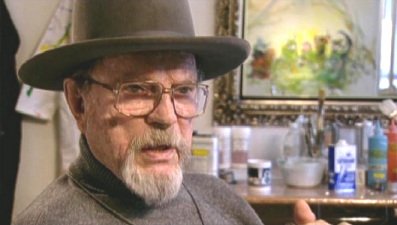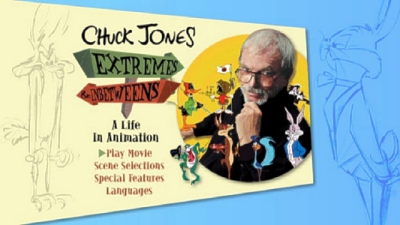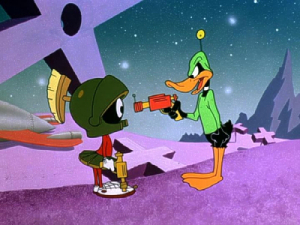Charles M. "Chuck" Jones™
* (1912-2002) is one of the most revered animators, directors, and writers in the
History of Animation.
Chuck Jones - Extremes and In-Betweens, a Life in Animation
This biography, shown on American television as part of the PBS "Great
Performances" series, examines the life works of one of Hollywood's most
celebrated animators, Chuck (Charles M.) Jones. He is best known for
Warner Brothers cartoons featuring Bugs Bunny, Daffy Duck, Elmer Fudd,
Porky Pig, Road Runner, Wile E. Coyote, and Pepe LePew. Included are
plenty of behind-the-scenes descriptions of how an animated film is
made, and (best of all) many clips from Chuck's cartoons.
Celebrity appearances by WHOOPI GOLDBERG, MATT
GROENIG, RON HOWARD, JOHN LASSETER, LEONARD MALTIN, STEVEN SPIELBERG,
ROBIN WILLIAMS and more!
If you fell in love with Chuck Jones you can have a
DVD of Chuck from amazon
Storyboard:
A testament to the life, work and vigor of legendary cartoon director
Chuck Jones’, from animation’s pioneering days to some of the last
footage of Jones’ before his passing. He offers up his insights into the
characters he helped make famous, and there are contributions and
tributes from an all-star line up of colleagues, competitors and fans
who have found inspiration in Chuck’s early Warner Brothers shorts. As a
bonus we even get two cartoons looking as pristine as they come!
The Sweatbox Review:
“The two most important people in animation are Winsor McCay and Walt
Disney”, once said Chuck Jones. I’ll spare his modesty and add him to
that list (he was also one of these three that were recently the first
inductees into the Animation Hall Of Fame), as if there is one other
person who made as much impact on animation as those two other fine
fellows, then it is Jones, who along with Tex Avery steered animation in
a whole new direction. McCay brought life, Disney gave character and
music, but Jones and his team at Warners made animated
CARTOONS,
and even their trade mark steel guitar-accompanied logo is now
synonymous with what a cartoon actually is (and referenced as recently
as in the
Roger Rabbit “Maroon Cartoons”).
The documentary starts with a montage of frantic and zany Chuck
moments, during which a top cast of filmmakers, friends and fans pay
tribute. Joining the likes of Ron Howard (who directed the live-action
version of Jones’
The Grinch) and Robin Williams are Whoopi Goldberg, Joe Dante, Steven Spielberg (who considers
One Froggy Evening the “
Citizen Kane of animated shorts”), John Lasseter and Simpsons creator Matt Groening.
The film follows Chuck’s life in chronological order, starting with
The Early Years, as Jones reveals his first influences, such as McCay’s
Gertie The Dinosaur
and Chaplin’s comic silent movies. Working his way up from cell washer
to animator, Jones worked for directors such as Friz Freleng, Bob
Clampett and Tex Avery in the Leon Schlesinger animation building,
nicknamed Termite Terrace after their non-animator companions. Here
Chuck would develop his own personal style, directing early shorts such
as
The Draft Horse and
The Dover Boys while making his mark on established characters Bugs Bunny, Daffy Duck, Porky Pig and Elmer Fudd.
Over the years Chuck would direct some of the best and most fondly remembered Warners cartoons:
Super Rabbit (a great pastiche of the Fleischer
Superman shorts),
Rabbit Fire, Dripalong Daffy, Robin Hood Daffy and the simply brilliant
Duck Amuck.
Extremes And Inbetweens also pauses occasionally to analyse particular shorts, such as the previously mentioned
Duck Amuck, as well as
Rocket Squad, The Rabbit of Seville, What’s Opera, Doc? and the Academy Award winning
The Dot And The Line.
There’s also a look at Jones-created characters Pepe Le Pew, Marvin
the Martian, Hubie and Bertie, Michigan J. Frog, the Three Bears and, of
course, Wile E Coyote and the Road Runner. The documentary also covers
some of the vocal latent behind the drawings (though no real mention of
Mel Blanc), the use of music in the WB cartoons, and that classic
exaggerated-line WB style. But the story does not end when Jones finally
left the Warners lot, following his post-Bugs-and-co. achievements with
The Grinch, his rather less successful re-invention of Tom and
Jerry, and triumph at the 68th annual Oscars when he won a lifetime
achievement award.
Chuck Jones: Extremes And Inbetweens, A Life In Animation is a very rewarding watch, as in depth as some other histories of the Warners Studio (1975’s
Bugs Bunny Superstar
springs to mind). For over an hour, it’s wonderful to be in the company
of a man who learnt his profession from the bottom up, and a man whose
intelligent views on human behavior were reflected in his films, from
which we in turn can all learn a great deal. Mr Jones, you are sorely
missed.
Is This Thing Loaded?
Hop down to the Special Features and there’s even more to enjoy and enlighten.
A Chuck Jones Tutorial: Tricks Of The Cartoon Trade is a fantastic follow on to the main program. Featuring
extra interviews
with the main participants, this is a 14-minute look (presented, as
with the feature, in non-anamorphic widescreen) at Jones’ actual cartoon
technique, featuring subjects such as Zip Outs, Anticipation,
Exaggeration and Anthropomorphism, and comments from new generation
artists Glen Keane, Eric Goldberg and Rob Minkoff. It’s a very nice
addition, and is entertaining enough for casual film fans as it is for
animation artists and buffs, even if it does end rather abruptly.
A
couple of pencil tests follow, the first for the classic Ken Harris-animated dance sequence in
Mississippi Hare.
This short clip has been given an appropriate “projector” audio track
that suits the material well. Much more substantial is an almost
seven-minute look at a work-in-progress version of the Jones-directed
The Grinch.
Much of the animation is completed, although some music and dialog is
missing. The clip condenses the first half of the story down adequately
for the purposes here and when the film does revert to the pencil
animation stage it is fascinating stuff! Both of these early animation
production clips are presented in their original full-frame ratios.
Chuck Jones Career Highlights isn’t a clip montage retrospective but a few
pages of background text,
which touch on important moments in Jones’ work. Of better use (but
probably too long, which is most certainly why it is not included here)
would have been a complete filmography. The Highlights give no dates to
any of the events, so unless you are a real fan, this will come across
as a once only “oh-that’s-what-he-did” read.
A couple of much better extras are the invaluable inclusions of
two classic Charles M Jones shorts from the Warner Bros archives.
Feed The Kitty
is an often talked about, but pretty routine cartoon, and the
historical reason or importance of its addition is not really explained
too deeply, apart from the fact that it seems to be very popular with a
few celebrity fans. Next up is the absolutely brilliant Duck Dodgers In
The 24th ½ Century, Chuck’s take on the space serials popular at the
time. Although this is an obvious one to put in with a Chuck Jones
retrospective, one can’t but help imagine if this has not actually been
included to drum up early buzz on Warners’ up-coming
Duck Dodgers television series.
However, both cartoons look amazing, having obviously gone through
some kind of extensive restoration. The main program does cover other,
more influential, Jones cartoons and it would have been nice to see a
few of the real classics (
What’s Opera, Doc? The Dot And The Line, High Note and
One Froggy Evening for starters), but both
Feed The Kitty and
Duck Dodgers are most welcome and provide a great teaser – hopefully all the WB shorts will look as good as this on disc when those
Looney Tunes collections start filtering through!
No added DVD-ROM material has been included, but for more on Chuck
(including the full filmography missing here) visit his website,
ChuckJones.com.
Case Study:
Warners’ custom snapcase strikes again, offset by some bright and
colorful cover art that emphasizes Chuck’s cartoon creation. The inside
foldout lists the index marks throughout the program and a pencil line
drawing of a late-era Bugs Bunny.
Ink And Paint:
Rather surprisingly, but most welcome, is the fact that
Extremes And Inbetweens
is presented in widescreen, preserving the 1.78:1 aspect ratio of the
new interview segments. On the other hand, and rather annoyingly, the
program has not been encoded to take advantage of anamorphic 16×9
enhancement, but although this does seem odd, it’s rather a moot point,
as the presentation is more than adequate, and the image will still look
fine if blown up on widescreen displays to fill the screen. Within this
letterboxed frame, the 1.33:1 cartoon sequences themselves have been
windowboxed and squeezed down in size in order for them to be shown in
their original aspect ratios. The makers of the documentary should be
commended for this, as it means that everything, from the interviews to
classic clips, can be seen as originally intended. The lack of 16×9
encoding is a small criticism, but overall this is a fine looking disc
and the cartoons look very clean.
Scratch Tracks:
The packaging states this as a two-track, left-and-right, stereo
release, but apart from the applause during the Academy Awards clip,
this seemed to be pretty much locked to the mono center channel for most
of the show. However, when you’re talking about a basic interview
set-up, with cartoon clips (which were originally mono anyway) I found
no reason to complain. The dialog comes through crisp and clear, the
music in the animated sequences has a nice “roundness” to it, while not
losing any depth, and everything is easy to understand. Additional
subtitles are provided in French and Spanish.
Final Cut:
If you are at all interested in the techniques or history of animation production I would urge you to pick up
Extremes And Inbetweens.
Simultaneously portraying a man and his philosophy, as well as a
genuine look behind-the-scenes at the processes that come together to
produce such classic animation, this is not some PR fluff dressed up as a
documentary, but a truly genuine look at a man who brought a great deal
to the animation table, changing the way cartoons actually thought, as
well as the general filmmaking process while he was at it. Although this
does not cover everything (the features
Gay Purr-ee and
The Phantom Tollbooth
are conspicuous absences), as a taster for the cartoons to follow on
DVD, this a good starting point, and a wonderful tribute to a wonderful
human being.







































